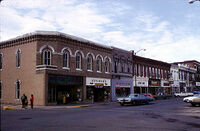NRHP: Nebraska City Historic District
Contents
Nebraska City Historic District
NRHP Reference #: 76001135
NRHP Listing Date: 19761029
Location
bounded by 5th Ave, 3rd, 19th, 1st Corso, Nebr City, Otoe County, Nebraska
View this property's location
View all NRHP properties on this map.
Summary
The Nebraska City Historic District, comprising fifty-eight square blocks, is a major residential neighborhood that had its beginnings in the 1850s. The historic district contains excellent examples of architectural styles popular during the mid to late nineteenth and early twentieth centuries including Greek Revival, Gothic Revival, Italianate, Queen Anne, Shingle, and Georgian Revival. These houses were occupied by some of Nebraska City's most prominent residents including George and Robert Hawke, Alexander Majors, William Fulton, and Robert Payne, who were involved in commercial and freighting ventures. The district also includes a small commercial area along Central Avenue (old Main Street). The earliest business activities of the city were concentrated along Central Avenue, which connected the Missouri River and what came to be known as Steam Wagon Road. The two-story masonry commercial buildings, which date from the 1870s and 1880s, replaced earlier structures, many of which were destroyed by fires in the 1870s.
Further Information
Bibliography
About the National Register of Historic Places
The National Register of Historic Places (NRHP) is the country’s official list of historically significant properties. To be eligible for the NRHP a property must generally retain their historic appearance, be at least 50 years old, and have the potential to be documented as historically or architecturally significant at either the local, state, or national level. The National Register of Historic Places is a National Park Service program administered by the Nebraska State Historical Society for the state of Nebraska. Visit the Nebraska State Historical Society's website to learn more about the program.
